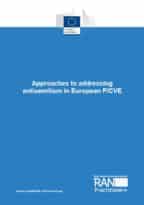Fonte:
Directorate-General for Migration and Home Affairs
Autore:
Aniko Felix
The place of antisemitism in P/CVE work within the EU
In October 2021, the European Union (EU) published the EU Strategy on Combating Antisemitism and Fostering Jewish Life (2021-2030), a first-of-its-kind strategy based on three pillars: 1) preventing and combating all forms of antisemitism; 2) protecting and fostering Jewish life in the EU; and 3) education, research and Holocaust remembrance. It is a comprehensive strategy, spanning education, culture and sport while providing anti-discrimination training for law enforcement personnel, protecting places of worship, and tackling antisemitic disinformation, hate speech and hate crime (online and offline). The emphasis is on using EU-funded targeted actions to achieve transnational solutions for antisemitism in contemporary Europe.
Another salient issue in the EU is the combating of all kinds of radicalisation by initiating and supporting programmes for P/CVE by all means. Although antisemitism and violent extremism are closely linked on many levels, preventive and countering efforts against violent extremism are not well coordinated or integrated with the corresponding efforts against antisemitism; these efforts tend to develop in parallel rather than in synergy. The study addresses this gap by examining to what extent P/CVE programmes take into account and concentrate on antisemitism.
The paper begins by briefly summarising the problem antisemitism poses within the EU, and why it presents a challenge for P/CVE programmes. This is followed by an overview and categorisation of various P/CVE approaches and programmes that either primarily address antisemitism or form part of larger P/CVE programmes with a focus on antisemitism.
The study aims at identifying gaps in existing initiatives, and discusses the part potentially played by a lack of diverse approaches in prevention levels or by the geographical or other type of disproportionate distribution of these programmes among EU Member States. Based on this information and providing concrete policy recommendations, the paper defines why and how P/CVE programmes should address the issue of antisemitism more systematically.
Definition of antisemitism and prevalence in the EU
Antisemitism is defined as a “certain perception of Jews which may be expressed as hatred toward Jews”. It can have both “rhetorical and physical manifestations directed toward Jewish or non-Jewish individuals and/or their property, toward Jewish community institutions and religious facilities”. Antisemitic attitudes are studied in surveys, while antisemitic violent incidents are collated in reports covering recorded antisemitic acts.
Finally, antisemitism at the discoursive level is mostly analysed by experts and the media. According to a representative survey conducted in 16 EU countries from 2019 to 2020, the acceptance of certain antisemitic attitudes increased at the societal level, and 20 % of respondents held traditional antisemitic views. There is, however, a considerable difference in the degree of antisemitism across individual Member States: from Greece (48 %) and Hungary (42 %) being the most antisemitic countries, to Sweden (6 %) and the Netherlands (3 %) having the least antisemitic views. Meanwhile, the results of a recent survey in Germany show that 20 % of adults hold antisemitic attitudes, but this increases to 33 % in young people aged 18 to 29.


